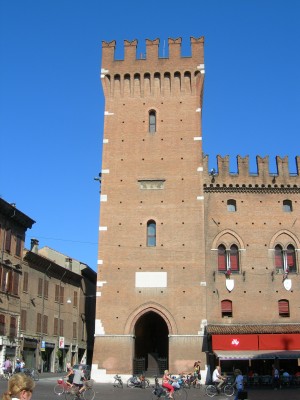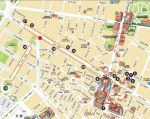TORRE DELLA VITTORIA (TOWER OF VICTORY)
The neo-medieval ‘Tower of Victory’ is a commemorative building designed by Girolamo Savonuzzi upon the request of Italo Balbo. Overlooking Piazza Trento Trieste, it currently houses a memorial to those lost in WWI featuring the Vittoria del Piave Incatenata: a sculpture of victory in chains by Arrigo Minerbi.
Building history
The Torre della Vittoria is a replacement of the pre-existing Torre di Rigobello, which collapsed in the earthquake that shook Ferrara in 1570.
Reconstruction of the tower was initiated at the behest of Italo Balbo, founder of the Fascist Party of Ferrara and under-secretary to the Ministry of Aeronautics at the time, and by his close friend Renzo Ravenna, who was Podestà (Chief Magistrate) of Ferrara from 1926. The Fascist state infused monuments to the fallen with a spirit of nationalism and the idea of the sacredness of war, in line with its political pedagogy based on obedience and sacrifice. Directed by Nello Quilici, the Ferrara daily Il Corriere Padano published a public appeal for funding to build the tower, receiving donations from 4,000 people, mainly from the Jewish community. Balbo contributed 500 lire and Chief Magistrate Ravenna 200 lire.
On 1 November 1928, Torre della Vittoria was inaugurated in the presence of King Vittorio Emanuele III and high-level representatives of the various local authorities.
It is currently owned by the municipality. Daily access is allowed only to the memorial area.
The public cannot access the tower, except on special occasions.
Building description
Designed as a fortified tower, it stands at a height of 57 m, with a structure composed of a reinforced concrete frame covered in characteristic red brick produced in local kilns. Istrian stone pieces rhythmically interrupt the brick at the corners, reinforcing the facing while also echoing the two-tone colour scheme of the towers of nearby Castello Estense. The top is crowned by Ghibelline (swallow-tail) crenellations resting on corbels. In 1928, a bell cast with the bronze of Austrian cannons was added, supported by six eagles and decorated with a celebratory inscription and images of the patron saints of Ferrara (Saint George and Saint Maurelio).
The lower part of the building - directly accessible from the street and preceded by a large pointed arch - houses a memorial installed by the Fascist administration to honour the citizens of Ferrara who died during WWI. Above the shrine is a large groin vault whose segments feature fourteenth-century-style decorations: a deep blue background dotted by golden stars.
In the centre of the space, a golden bronze statue titled ‘The Victory of the Piave in Chains’ by local Ferrara sculptor Arrigo Minerbi stands atop a high pedestal. The nude female figure crosses her arms in a sorrowful embrace within her long wings, alluding to a costly victory that involved the loss of many young soldiers in the Second Battle of the Piave (also called the Battle of the Solstice) in June 1918. The personification of Victory was quite popular as an allegory within war memorials and, in Minerbi's case, the complete nudity of the winged Victory, classically depicted as she is weighed down by shackles that bind her legs to the base of a bridge over the Piave River, is the quintessence of the best qualities of heroic sculpture.
The pedestal below the sculpture features a Latin epigraph stating: I / above the waves of battle / bound, hold the victors / now tend to me / dear citizens / and to the past, tether propitious future events. The intrados of the pointed entry arch bears an inscription as well, the words of the Director of the Ariostea Library, Giuseppe Agnelli: Heroum Memoria Perpetuo Revirescit.
The shrine is closed by an elegant art nouveau wrought iron gate designed by Savonuzzi.
Built between 1926 and 1928 using a reinforced concrete cage frame, it is covered in brick and strengthened in the corners by occasional stone pieces. The abandonment of more traditional masonry construction methods was a financial choice, making the walls faster and cheaper to build.
The use of a neo-medieval style for buildings that were meant to evoke the values of community and liberty was part of the late Romantic concept of what restoration was, in which medieval architecture was considered a potential national style capable of expressing the ideals of political and civil independence.
The tower is seemingly well preserved and has not undergone any interventions that have altered its neo-gothic appearance.
Context and surroundings
Fascism flooded large and small cities with monuments that celebrated war heroes, considered the precursors to the Fascist hero archetype. Torre della Vittoria and the adjacent Palazzo Municipale were the only public buildings in Ferrara that, leveraging patriotic, nationalist sentiments, involved financial contributions from the public for their construction.
The revival of Ferrara planned by the Balbo-Ravenna team to redevelop the city's entire urban fabric and restore it to its Renaissance splendour also involved the simultaneous cropping up of other public structures, such as the Teatro Nuovo (S. Boari), the stadium (G. Gandini, C. Savonuzzi), the Poledrelli Primary School (G. Savonuzzi) and the Palazzo delle Poste (A. Mazzoni), employing the best local professionals.
Thanks to its central location and imposing presence, Torre della Vittoria stands in dialogue with the cathedral's Albertian bell tower and the Torre dei Ribelli, rebuilt with twentieth-century features by Marcello Piacentini between 1954 and 1956. In addition, in terms of architecture and urban planning, it marks the boundary of the original ducal residential area, closed to the north-east by Castello Estense.
The Torre della Vittoria is part of the Palazzo Municipale building, maintaining its historic and civic importance. The memorial, dedicated after WWII to all those fallen in all wars, keeps the memory alive of all those who have died in the name of freedom.
The building in tourist itineraries
The central location of the tower is convenient to the main monuments of medieval Ferrara.
Registered by the Superintendency for Archaeology, Fine Art and Architecture, the building is now part of the ‘Ferrara, a Twentieth-century City’ itinerary.
Note
Card text by Ulisse Tramonti and Barbara Pizzo
Bibliography
- Bassi, Carlo, Peron, Marica - Savioli, Giacomo, Momenti dell’attività dell’ingegnere Ciro Contini a Ferrara fra 1910 e 1913, con una appendice, in Ferrara disegnata. Riflessioni per una mostra, Arstudio C, Portomaggiore (Ferrara) 1986
- Lucio Scardino, Itinerari di Ferrara moderna, Alinea Editrice , Ferrara 1995
- Lucio Scardino, Arrigo Minerbi e gli scultori della Fornace Grandi a Bondeno, Ferrara 1998
- Andrea Poggiali, I segni della guerra. Lapidi e monumenti in provincia di Ferrara, ai caduti italiani nel XX secolo, Volume II, Claudio Nanni Editore, Ravenna 2002
- Ilaria Pavan, Il podestà ebreo. La storia di Renzo Ravenna tra fascismo e leggi razziali, Laterza, Bari 2006
- Antonella Guarnieri, Il fascismo ferrarese. Dodici articoli per raccontarlo, Tre Sogni, Ferrara 2011
Sitography
Related Themes
Related Itineraries
Compiling entity
- Assessorato alla Cultura e al Turismo, Comune di Ferrara



